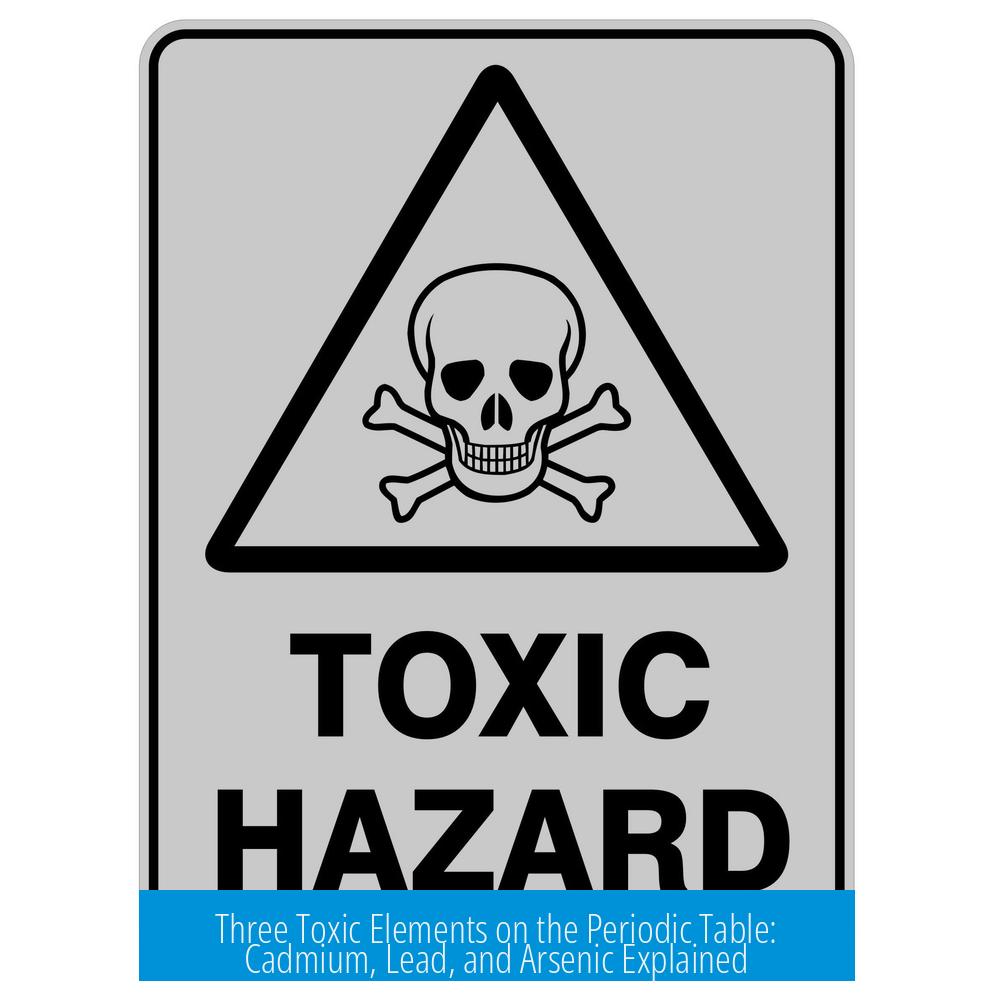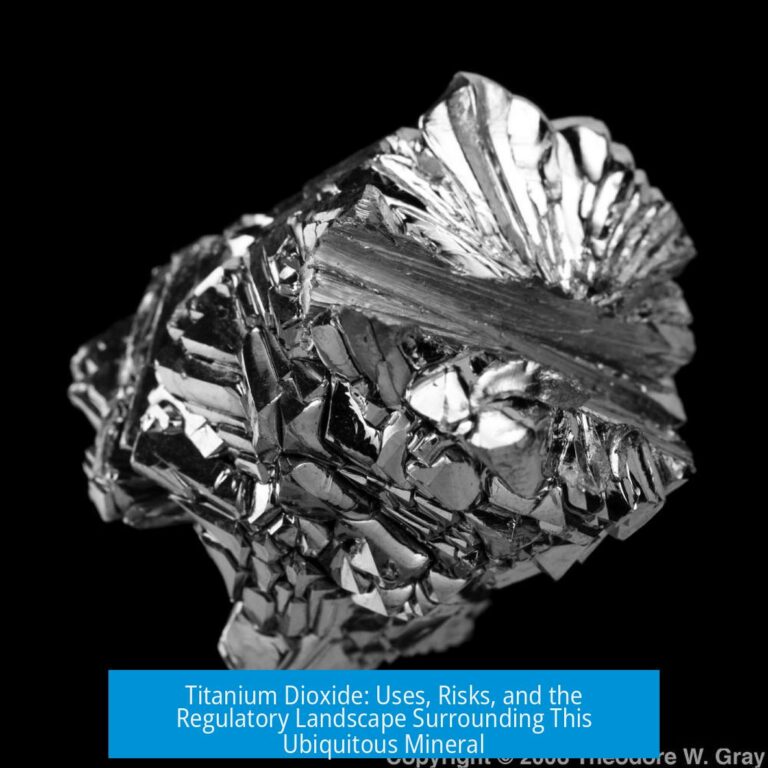Three of the Most Toxic Elements on the Periodic Table: Cadmium, Lead, and Arsenic

Cadmium, lead, and arsenic rank among the most toxic elements known in chemistry, exhibiting significant health hazards through bioaccumulation, neurological damage, and carcinogenic effects. These elements have been historically used in various industrial and chemical applications despite their toxicity, posing risks that require careful handling and regulation.
1. Overview of Cadmium, Lead, and Arsenic Toxicity
Cadmium (Cd), lead (Pb), and arsenic (As) are naturally occurring elements but exhibit considerable toxicity when humans or ecosystems are exposed to them.
- Cadmium: Used in plating and batteries, cadmium is highly toxic even at low doses. Occupational exposure during cadmium plating demands strict safety measures to prevent inhalation or ingestion.
- Lead: Widely recognized for its neurotoxicity, lead bioaccumulates in the body, causing damage especially to the nervous system. Historically, lead compounds such as lead(II) chromate (PbCrO4) served as pigments in paints.
- Arsenic: Known for its carcinogenic and toxic properties, arsenic exists in various natural mineral forms. Obtaining pure arsenic for analytical purposes is challenging due to safety concerns and its hazardous nature.
2. Why Are These Elements Toxic?
The toxicity of these elements arises from their biochemical interactions and accumulation within the body:
- Bioaccumulation: Lead, particularly, accumulates over time in bones and tissues. Its persistence disrupts normal biological functions.
- Neurological Effects: Lead interferes with neurotransmitter release and disrupts ion channels critical for brain function. This leads to cognitive deficits and nervous system disorders.
- Cellular Damage: Cadmium and arsenic generate oxidative stress and interfere with enzyme systems. This can cause cellular damage, promote cancer, and impair organ function.
- Metabolic Disruption: These metals mimic or replace essential metal ions such as calcium and zinc, disturbing metabolic pathways and affecting DNA repair mechanisms.
Despite lead’s natural occurrence, its biochemical mimicry and persistence make it harmful. The human body’s interaction with these elements contrasts with how it uses essential metals like iron for oxygen transport, revealing why certain metals cause harm and others do not.
3. Comparison with Other Toxic Elements

While cadmium, lead, and arsenic are notably toxic, other elements also present serious risks:
| Element | Common Toxic Effects | Relevant Notes |
|---|---|---|
| Mercury (Hg) | Neurotoxicity, organ damage | Lethal in high doses; accumulates in fish |
| Thallium (Tl) | Extremely toxic, neurological damage | More toxic than lead and arsenic in some contexts |
| Beryllium (Be) | Chronic lung disease, carcinogenic | Most toxic non-radioactive element per some sources |
| Fluorine (F2) | Highly reactive, lethal gaseous toxicity | Deadly even in minute quantities |
Several other elements such as osmium tetroxide, antimony, tellurium, and hexavalent chromium share toxic qualities. The toxicity spectrum varies with chemical form, exposure route, and dose.
4. Practical Contexts of Toxicity and Usage
Despite their dangers, cadmium, lead, and arsenic compounds have found uses across industry and education:
- Lead(II) Chromate: Used as a bright yellow pigment in paints. Its vivid color famously demonstrated in chemistry classes, but its toxicity limits current use.
- Cadmium: Employed for plating metals and in batteries. Workers handling cadmium plating must use protective equipment due to inhalation risks.
- Arsenic: Historically used in pesticides and wood preservatives. Today, arsenic presence in drinking water is a public health concern in some regions.
Fluorine gas, though not part of the initial triad, poses extreme inhalation hazards. Furthermore, combining fluorine with phosphorus compounds can create destructive reactions.
5. Challenges in Handling and Analysis
Obtaining sufficiently pure samples of toxic elements for study is difficult due to regulatory limitations and health risks. For instance, arsenic used in pro analysi grades is rare and costly, pushing specialists to rely on native forms. Handling such elements necessitates strict lab protocols to mitigate exposure.
6. Understanding Toxicity Beyond Natural Origin
The toxicity of naturally occurring elements depends on chemical behavior, reactivity, and biological interactions. An element like iron is essential due to its role in oxygen transport, while lead does not serve physiological roles and instead disrupts biological systems. Toxicity arises when the element interferes with cellular function, enzyme activity, or causes cumulative damage over time.
Key Takeaways
- Cadmium, lead, and arsenic are among the most toxic elements, causing neurological, carcinogenic, and systemic effects.
- Lead bioaccumulates and disrupts neurological pathways, explaining its neurotoxicity.
- Other highly toxic elements include mercury, thallium, beryllium, and fluorine, each with distinct hazards.
- Despite toxicity, cadmium and lead compounds have industrial and educational applications, requiring careful handling.
- Toxicity depends on biochemical interactions rather than solely on whether elements are naturally occurring.
- Pure arsenic samples are difficult to source due to health risks, underscoring challenges in toxic element research.
What makes lead, cadmium, and arsenic so toxic compared to other elements?
These elements interfere with biological processes. Lead bioaccumulates, affecting the nervous system. Cadmium and arsenic disrupt cellular functions. Their chemical properties allow them to bind with enzymes and proteins, causing damage.
Why does lead cause neurological issues in the human body?
Lead accumulates in body tissues and mimics calcium, disturbing nerve signals. This affects brain function, especially in children. Neurological damage results from disrupted communication between neurons.
Are these toxic elements used in everyday products?
Yes. Lead compounds, like Lead(II) chromate, have been used as pigments in paint. Cadmium is used in plating and batteries. Arsenic appears in pesticides and some industrial processes. Their use has declined due to toxicity concerns.
How does cadmium plating relate to its toxicity?
Cadmium plating involves coating metals with cadmium to prevent corrosion. Handling cadmium requires strict safety because it can enter the body through inhalation or skin contact, leading to toxic effects.
Why is pure arsenic hard to obtain for analysis?
Pure arsenic is rare and expensive due to its toxicity and regulation. Many samples are native forms mixed with impurities. Safe handling and strict control limit its availability for study.





Leave a Comment